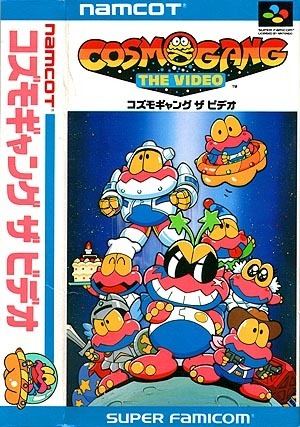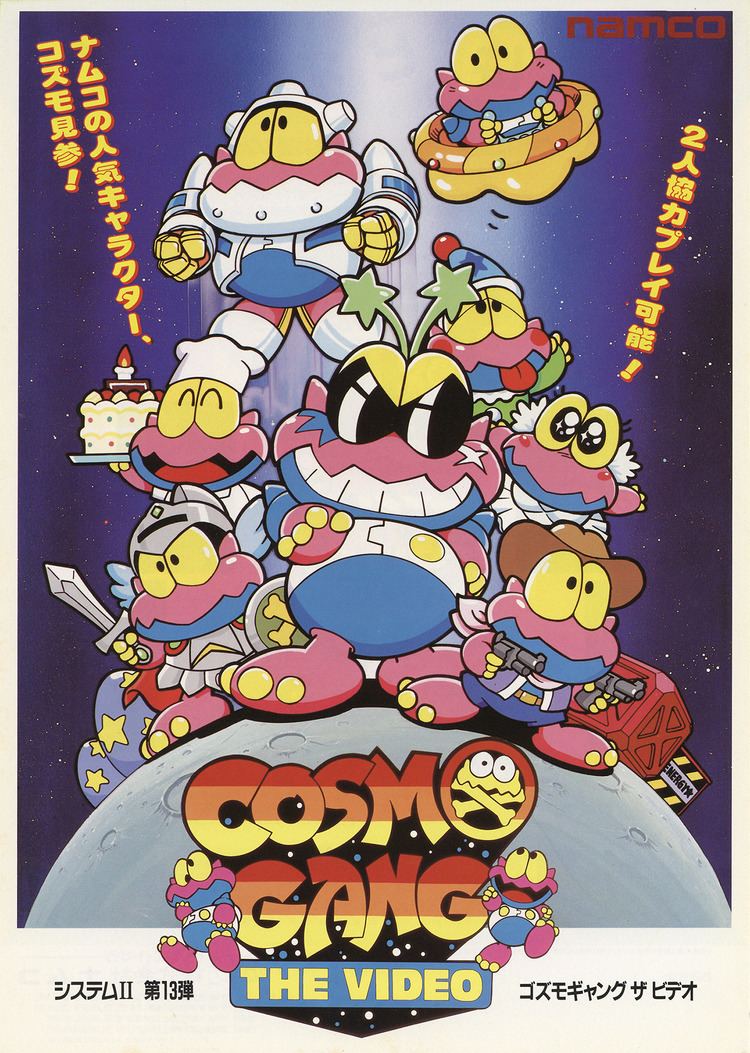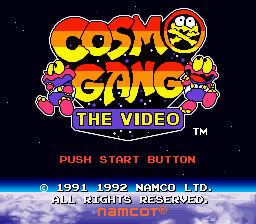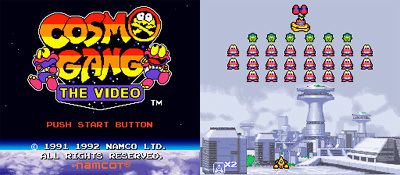10 /10 1 Votes
Designer(s) Kohji Kenjoh | 5/5 Emuparadise Initial release date December 1991 | |||||||||||||||||||||||||||||||||
 | ||||||||||||||||||||||||||||||||||
Composer(s) Yoshie Arakawa (Strong Yoshie) Release date(s) ArcadeJP: December 1991Super FamicomJP: October 29, 1992 (original)JP: August 4, 2009(Virtual Console) Genre(s) Fixed shooter, Cute 'em up Mode(s) 2 players can play simultaneously Cabinet Upright, cabaret, and cocktail Similar Cosmo Gang the Puzzle, Dragon Saber, Dragon Spirit, Galaga '88, Märchen Maze | ||||||||||||||||||||||||||||||||||
Cosmo gang the video arcade 2 player 60fps
Cosmo Gang: The Video (コズモギャング・ザ・ビデオ, Kozumo Gyangu: Za Bideo) is a fixed shooter arcade game that was released by Namco in 1991; it runs on Namco System 2 hardware, and is based on a redemption game called Cosmo Gang that was released in the previous year (and licensed to Data East for US manufacture and distribution). A sequel called Cosmo Gang: The Puzzle was released in 1992 - and an adaptation of it with Pac-Man characters was released in 1993 for the Super Nintendo Entertainment System and Sega Genesis under the title Pac-Attack.
Contents
- Cosmo gang the video arcade 2 player 60fps
- Cgr undertow cosmo gang the video review for super famicom
- Gameplay
- References

Namco later developed a Super Famicom conversion of this game, released on October 29, 1992; this version was rereleased for the Wii Virtual Console on August 4, 2009. Although the arcade version was released in the United States both console releases were Japan-only.

Cgr undertow cosmo gang the video review for super famicom
Gameplay

The players must take control of two spaceships (1P's is yellow, while 2P's is white), which are positioned at the bottom of the screen; the Cosmo Gangers (who are the enemies of the game) will fly into view from the left and right sides of the screen while firing hails of bullets down at them before taking their place in a formation, but some will break away from the formation to fly directly towards them. They will then begin to attack them - and the gameplay is similar to Namco's older Galaxian games, except for the facts that two players can play simultaneously, some of the enemies shall leave powerups behind when killed, the players' ships cannot get captured and retrieved, and the Challenging Stages are a video simulation of the original Cosmo Gang: the players must endure twenty-four seconds without the Cosmo Gangers stealing one of their energy containers (their ships are also transformed to look like the original redemption machine's light-guns during these stages). In the two-player mode (which was the basis for Galaga Arrangement), lives are shared between players, so if one player is killed, it will indirectly kill the other one as well - and if either player had won the Armor shot powerup by killing a Bakuto (one of the sunglasses-wearing, ship-flying Cosmo Gangers), it will fly up into the air and the other player will have the chance to catch it before it falls off the bottom of the screen. And, as in Toy Pop (which was the only game Namco released in their last 8-bit year, 1986, that did not use a Yamaha YM2151), both players' scores are combined for the two-player mode; however, the points awarded for a Challenging Stage shall not get divided between them, and they will both receive the appropriate value. The "P" ("Point Up") powerups shall also increase the players' respective score multipliers (as indicated by the text "X2" in the screenshot above), up to a maximum of 16 - and if either player collects one after his or her score multiplier has reached 16, he or she will receive 7650 (Namco's goroawase number) x16 (122400) points instead (the multipliers are also reset after a Challenging Stage). The Rally-X Special Flag also reappears, as an "extra life" powerup (but on account of lives being shared between players in the two-player mode, it applies to both of them in that case), and the "Change" and "Supernova" powerups only appear in the two-player mode; the former swaps over both ships' "2.5D" positions at the bottom of the screen while the latter causes the secondary part of the YM2151-generated song to cut out (but the primary part of it continues) as the text "SHOOT ME!" appears on the left (or right) side of the ship whose "2.5D" position is on the top (Player 2 by default), and once the other player has fired enough shots at it, it will launch a hail of bullets up at the Cosmo Gangers. Both players can then repeat this process, until either one of them (or the last Cosmo Ganger on the stage) gets killed - and this game's final boss, Don Cosmo (who has four attack phases, one for each of his life bars) also wears an inverted cross (like the fourth boss of Splatterhouse) around his neck. At the end of this game, if either (or both) players were killed less than ten times (or not killed at all), they will receive a maximum of 10000000 points (it decreases by 1000000 for each time a player is killed); the end credits were also originally displayed only in Japanese, but in the US version, they have English text added below them. At the end of a two-player game, both players will also have to enter their initials on the high-score table together.


